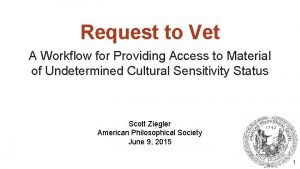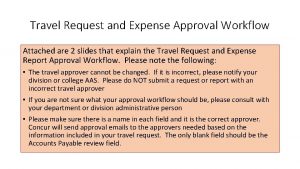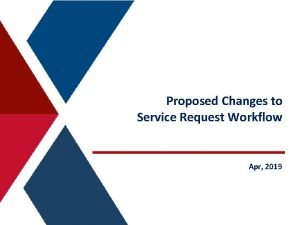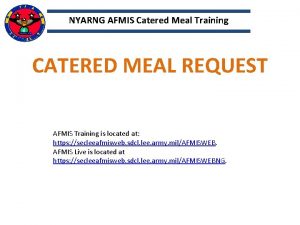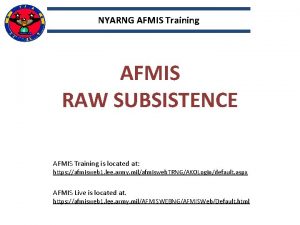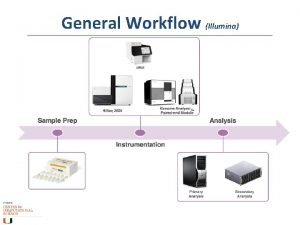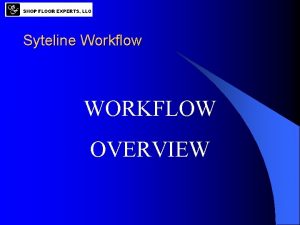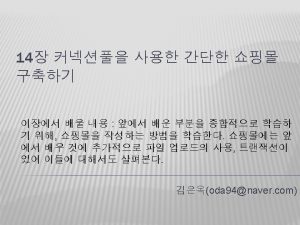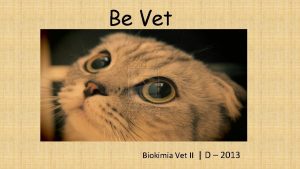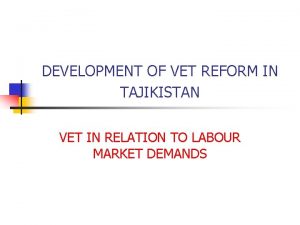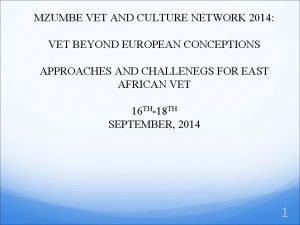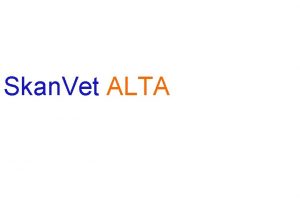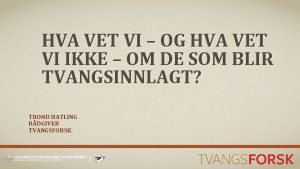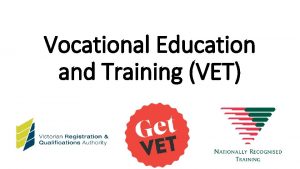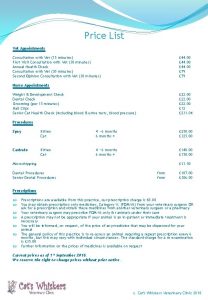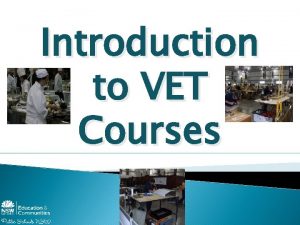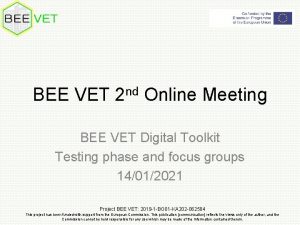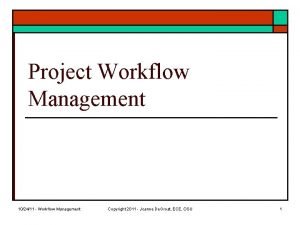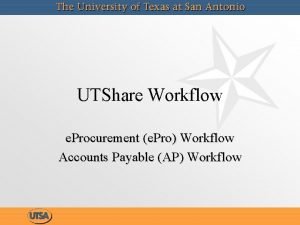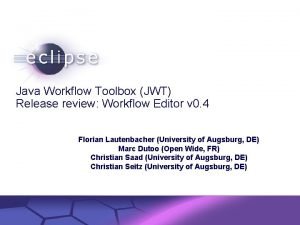Request to Vet A Workflow for Providing Access























- Slides: 23

Request to Vet A Workflow for Providing Access to Material of Undetermined Cultural Sensitivity Status Scott Ziegler American Philosophical Society June 9, 2015 1

What To Expect from this (Very Fast) Talk ● Background about the APS and our history of collecting Native American-related material ● Brief introduction to our Protocols for the Treatment of Indigenous Materials ● Case study: using the Protocols for a Native American-related collection 2

Background: Collecting Material Related to Native Americans It all started with Thomas Jefferson. And it’s only got more complicated since then. 3

Protocols and Online Publishing “APS will follow these protocols in classifying materials and in honoring requests for viewing, reproduction of, or on-line publishing of indigenous materials that have been classified as either culturally sensitive or whose classification is yet undetermined. ” APS Protocols for the Treatment of Indigenous Materials, Article 2, Section B (http: //www. amphilsoc. org/library/protocols-for-indigenous-materials) 4

Putting our Practice Where our Policy Is; or, The Franz Boas Papers and Determining the Undetermined ● A little over 45, 000 letters ● All of them digitized and in the Digital Library ● Their classification is yet undetermined. 5

Options, Options Around 45, 000 letters, some of which might be culturally sensitive. We could: 1. Keep all the letters restricted forever 2. Open all the letters immediately 3. Find a middle road a. Restrict every letter until we vet it for cultural sensitivity. 6

Vetting ~45, 000 Letters: Where to Start? Option 1: Just start at the beginning o o Letters are arranged alphabetically We could just start with the A’s and end with the Z’s 7

Vetting ~45, 000 Letters: Where to Start? Option 2: Let scholars tell us what they’d like to see Not all of the items in the collection is of equal scholarly worth o The point of all of this is so people can use these items, let’s hear from those who use them o 8

Decision Made! ● We’ll restrict every letter until it is vetted. ● We’ll vet what scholars want to see. ● Items that are not culturally sensitive will be publically available through the Digital Library. The only thing left to do is … All the work 9

The Work: 1. Provide access to everyone in our Reading Room. 2. Restrict (at least for now) access to everyone else. 3. Create a workflow to vet each item. 4. Explain all of this to everyone. 10

The Work: 1. Provide access to everyone in our Reading Room. a. b. c. Auto log-in via IP Address; User roles via Drupal; Mirror public finding aids with in-house versions with links to digitized items. 2. Restrict (at least for now) access to everyone else. 3. Create a workflow to vet each item. 4. Explain all of this to everyone. 11

The Work: 1. Provide access to everyone in our Reading Room. 2. Restrict (at least for now) access to everyone else. a. b. XACML restrictions at the collection-level XACML policy set to cascade to sub-collection and items via Islandora settings 3. Create a workflow to vet each item. 4. Explain all of this to everyone. 12

The Work: 1. Provide access to everyone in our Reading Room. 2. Restrict access (at least for now) to everyone else. 3. Create a workflow to vet each item. a. b. c. Find the closest in-house workflow Modify it as needed See next 7 slides 4. Explain all of this to everyone. 13

Request Comes In Workflow Head of Manuscripts (Based on our Reference Request Workflow) Inspects Item Native American-related? Culturally Sensitive? CNAIR Yes/Maybe Yes No Proceed to Tribes No Change Description/ Unrestrict Item Contact Patron 14

The Usual Way Links in Finding Aids Lead Directly to Items in the Digital Library 15

But For Restricted Content We’d Have ~45, 000 Access Denied Links. 16

Between a Link and a Denied Page Info about why you’re seeing this form, and what info you should supply. “This item has not yet been vetted for cultural sensitivity concerns” A Webform: ● A chance to explain what we’re doing ● A chance for users to identify what they’d like to see ● Automates the tracking (via URL key) of the item j. Query popup for additional information and link to tutorial 17

Info From Form Date Submitted Item to Vet (auto-captured PID) Assigned to (Head of Mss, CNAIR staff) Needs more review: (yes/no) Item Cleared: (yes/no) Patron Contacted: (yes/no) ● Patrons add name and contact information ● Form collects more information than the patron sees o PID of item taken from URL o Default settings for admin fields 18

Clearing Item, Changing Links ● Remove XACML restriction at the item level ● Replace link to webform with link to item in Digital Library ● Send patron email with link 19

The Work: 1. Provide access to everyone in our Reading Room. 2. Restrict access (at least for now) to everyone else. 3. Create a workflow to vet each item. 4. Explain all of this to everyone. a. b. c. d. j. Query tooltips in finding aids with text and links; Tutorials; About pages; Boilerplate reference staff explanations 20

Where We Are Now ● Started all this in January 2015 ● As of early June, we’ve cleared just over 1, 000 letters with this workflow ● (Others are cleared in bulk in anticipation to specific requests through this workflow) ● Setting the framework for other collections in the future 21

Request An Object be Vetted! Visit http: //www. amphilsoc. org/library and follow the links to see the tutorials and notices. 22

Thank You! Scott Ziegler Web Development Library/Assistant Head of Technology American Philosophical Society sziegler@amphilsoc. org 23
 Vet to vet
Vet to vet Vet the request
Vet the request Travel request approval workflow
Travel request approval workflow Service request workflow
Service request workflow Afmis web
Afmis web Afmis mem login
Afmis mem login Terminal access controller access control system
Terminal access controller access control system Terminal access controller access-control system
Terminal access controller access-control system Tobinskatten för och nackdelar
Tobinskatten för och nackdelar Referat mall
Referat mall Shingelfrisyren
Shingelfrisyren Lågenergihus nyproduktion
Lågenergihus nyproduktion Punkthöjd karttecken
Punkthöjd karttecken Vanlig celldelning
Vanlig celldelning Rbk mätning
Rbk mätning Arkimedes princip formel
Arkimedes princip formel Elektronik för barn
Elektronik för barn Densitet vatten
Densitet vatten Tack för att ni har lyssnat
Tack för att ni har lyssnat Smärtskolan kunskap för livet
Smärtskolan kunskap för livet Jiddisch
Jiddisch Novell typiska drag
Novell typiska drag Fimbrietratt
Fimbrietratt Trög för kemist
Trög för kemist

